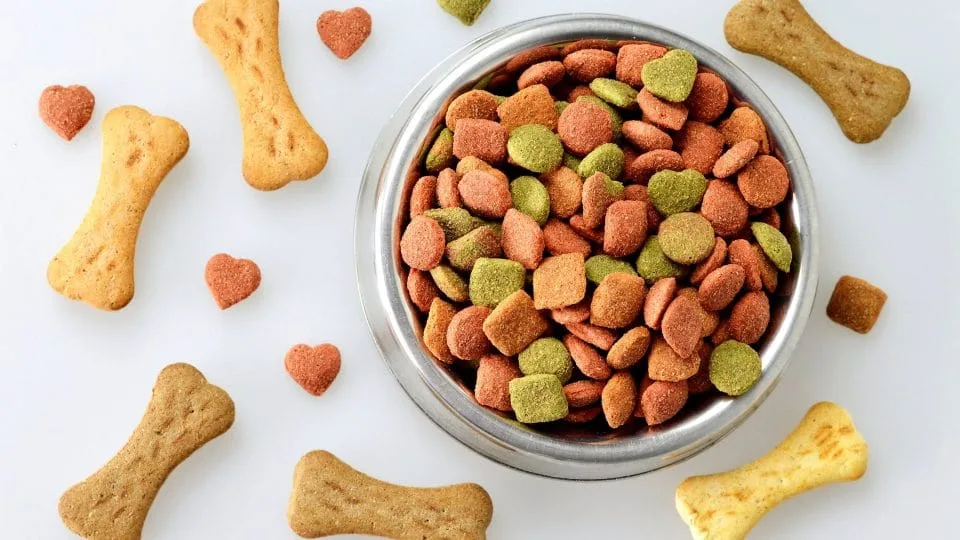The Canine Digestive System: Exploring the Basics
A dog’s digestive system is designed to break down and absorb nutrients from raw, meat-based foods. This allows dogs to thrive on a diet similar to what their wolf ancestors ate in the wild. Understanding the anatomy and function of the canine digestive tract provides insight into why a species-appropriate raw diet is ideal for your dog’s health.
The canine digestive system begins with the mouth, where dogs use their sharp teeth to tear and shred food. Powerful jaws facilitate mechanical breakdown of food. Enzymes in saliva, such as amylase, begin chemical digestion.

Once swallowed, food travels down the esophagus to the stomach. Here, hydrochloric acid and protease enzymes work together to further break down food at a rapid rate. The highly acidic environment kills bacteria and continues the process of protein digestion.
Partially digested food then moves from the stomach into the small intestine, where the majority of nutrient absorption occurs. The small intestine is the site of continued enzymatic digestion by proteases, lipases, and carbohydrases. These enzymes break down proteins, fats, and carbohydrates into simpler compounds that can be absorbed through the intestinal wall and into the bloodstream.
The large intestine absorbs remaining water from undigested material before it passes out of the body as feces. Healthy populations of beneficial bacteria in the large intestine also play a role in digestion.
Overall, the canine digestive tract is short and designed for rapidly assimilating nutrient-dense foods like raw meat, bones, and organs. The simplicity of dogs’ digestive systems allows them to thrive on a biologically appropriate raw diet.
Raw Food Diet for Dogs: A Brief Overview
Feeding a raw food diet is the best way to provide complete and balanced nutrition for dogs in line with their evolutionary needs. Let’s explore the basics of raw feeding for canines.

What Is a Raw Food Diet?
A raw dog food diet aims to mimic the natural ancestral diet of dogs in the wild. It involves feeding dogs raw, unprocessed meats, bones, organ meats, and vegetables. Avoiding high heat processing preserves nutrients and enzymes that are critical for health yet damaged by cooking.
Components of a properly balanced raw diet for dogs typically include:
- Muscle meats like chicken, beef, pork, turkey, etc.
- Raw meaty bones like chicken wings and necks.
- Organ meats like liver and kidney.
- Fish like sardines and salmon.
- Raw eggs.
- Leafy greens, veggies, and some fruits.
- Healthy oils like fish oil.
The ratio of meat, bones, and organs is tailored to meet each dog’s needs based on factors like age, activity level, and health status.
Benefits of Raw Food for Canines
Feeding species-appropriate raw food provides many benefits for dogs:
- Improved digestion and nutrient absorption.
- Healthier skin and coat.
- Better oral health.
- Optimal body condition and weight.
- Increased energy levels.
- Strengthened immune function.
- Improved stool quality.
- Reduced allergies.
The natural enzymes, vitamins, and minerals in raw foods support optimal canine health and longevity in a way commercial kibble simply can’t match. Just as with a human ancestral diet, raw feeding harnesses a dog’s evolutionary adaptions for thriving health.
Enhancing Digestion with Raw Food
The enzymes, moisture content, and nutritional profile of raw food makes it highly digestible for canines. This supports improved nutrient absorption and a balanced microbiome.
Improved Nutrient Absorption
Cooking denatures proteins and damages enzymes needed for breaking down and absorbing nutrients from food. Feeding a raw diet provides dogs the enzymes they need for optimal digestion.
Meat protein in its raw form is easier for dogs to metabolize than the coagulated proteins in cooked meat. The amino acids in raw proteins are more available for absorption. Raw bones provide calcium that is more bioavailable. Overall, dogs fed raw food diets digest and absorb nutrients more efficiently.

Balanced Gut Microbiome
The natural enzymes and probiotics found in raw foods help maintain a healthy balance of good bacteria in a dog’s gastrointestinal tract. Raw meat and bones provide substrates these beneficial microbes need to thrive.
In contrast, starchy kibbles and carbohydrate fillers in commercial dog foods alter the gut environment, allowing harmful bacteria to take over. This imbalance leads to inflammation, nutritional deficiencies, and weakened immunity.
Feeding species-appropriate raw food preserves normal gut flora essential for immune function, digestion, and overall health.
Key Nutrients in Raw Dog Food
Raw meat, organs, bones, and plant foods provide optimal nutrition. Let’s look at some of the most important nutrients for dogs found in raw diets.
Protein for Muscle Health
Raw animal proteins provide complete, highly bioavailable amino acids essential for building and maintaining lean muscle mass. Unlike the denatured proteins in kibble, raw meat proteins have their amino acid chains intact for optimal nutrition.
Healthy Fats for Wellbeing
Meats fed raw contain natural fatty acids like the omega-3s in salmon and sardines. These fats support healthy skin, a glossy coat, brain development, and immune function. Raw foods provide the full complement of fat-soluble vitamins A, D, E and K.
Essential Vitamins and Minerals
Organ meats like liver are naturally high in important B-vitamins. Raw meaty bones provide calcium and phosphorus. The vitamins and minerals in raw foods are present with their nutrient cofactors, allowing for proper absorption. This level of complete nutrition is impossible to replicate in processed dog foods.
The bioavailability of nutrients in a species-appropriate raw diet optimally nourishes dogs at a cellular level. This cannot be matched by any commercial diet full of processed, dead ingredients.

Digestive Health Issues in Dogs
Many chronic digestive problems in dogs are the result of inappropriate processed, carbohydrate-laden diets. Let’s explore some common issues and how raw feeding can help resolve them.
Common Digestive Problems
Chronic issues like inflammatory bowel disease, colitis, constipation, and anal gland impaction are related to poor quality kibble. The carbohydrates in dry foods alter the gut environment and promote inflammation.
Allergies to grains and other additives are also common, causing diarrhea, vomiting, and skin issues in dogs. Kibbled foods are linked to increased dental plaque, tartar, and gum disease.
Overall, commercial diets full of processed ingredients wreak havoc on canine digestive and immune systems over time.
How Raw Food Can Help
Transitioning to a raw food diet can resolve many digestive problems in dogs. The natural enzymes help improve digestion and absorption. Protein and fats help normalize stool while decreasing inflammation.
As the gut environment balances, the microbiome supports improved immunity. Dogs see a reduction in food allergies. Tartar buildup decreases and dental health improves. Raw bones clean teeth naturally.
In general, feeding species-appropriate raw food strengthens every part of the canine digestive system in ways commercial diets simply cannot.

Transitioning to a Raw Diet: Tips and Considerations
Switching your dog to a raw food diet takes some preparation and should be done gradually. Here are some tips for a successful transition:
Gradual Transitioning Process
Make the switch slowly over 2-4 weeks, starting with small amounts like 10% raw food mixed into their regular kibble. Gradually increase the ratio of raw food while reducing kibble. This allows your dog’s digestive system to adapt.
Introduce new proteins one at a time. Begin with novel proteins like rabbit, venison or duck to lower chances of food sensitivity.
Feed smaller, more frequent meals as you transition to raw. Monitor stool quality and adjust amounts accordingly. Ideal stool on a raw diet should be small, firm, and low odor.
Monitoring Your Dog’s Health
Keep an eye out for any digestive upset like diarrhea or constipation. If issues arise, revert back to a previous ratio of raw food to kibble and hold for a few days until stools normalize before continuing to increase raw ratios.
Weigh your dog weekly and monitor their body condition. Adjust amounts and ratios of meat, bones, and organs until their weight stabilizes. The transition may take 2-8 weeks depending on your dog. Be patient and let their health guide adjustments.
With proper transition time and close monitoring, your dog can thrive on a balanced raw food diet. Reach out to your vet for guidance if any severe issues occur.
Raw Food Recipes for Optimal Canine Digestion
To round out this guide on raw feeding for dogs, let’s look at some balanced meal ideas and precautions for providing homemade raw diets.
Balanced Raw Meal Ideas
A basic recipe for dogs includes:
- 50% raw meat (muscle and organ)
- 45% raw meaty bones
- 5% fruits/veggies
Here’s an example recipe:
- 8oz chicken thighs and breast (muscle meat)
- 4oz chicken liver and heart (organ meat)
- 4oz chicken necks and wings (raw meaty bones)
- 1/2 cup spinach, 1/4 apple sliced
Another recipe:
- 8oz ground beef 80/20 mix
- 2oz beef liver
- 2oz beef kidney
- 4oz meaty lamb ribs
- 1/2 cup pumpkin, 1/4 cup blueberries
Tailor recipes to your dog’s needs and introduce variety. Rotate through novel proteins to prevent sensitivity.

Precautions and Food Safety
Always source high-quality raw meats from reputable suppliers. Handle raw food properly to avoid contamination. Wash hands and bowls thoroughly.
If preparing homemade raw food, consult with a canine nutritionist to formulate balanced recipes. Work with your vet to ensure safety, especially for dogs with health conditions.
With care and common sense, a raw diet can get your dog’s digestion back on track and provide whole body health.
The Raw Truth: A Healthier Digestive Journey for Your Canine Companion
Dogs thrive when fed species-appropriate raw food that matches their evolutionary needs. Raw diets improve digestion, nutrient absorption, dental health, and more by providing natural enzymes, moisture, and unprocessed nutrients. By mimicking your dog’s ancestral wild diet, raw feeding enhances gastrointestinal health and overall vitality.
With a proper transition period and nutritional balance, your dog can reap the benefits of raw food. Their coat will shine, energy will soar, and eyes will brighten as their body gets the fuel it needs. Work with your vet and canine nutritionist to create balanced raw recipes tailored to your faithful companion.
Feeding raw just makes sense when you understand canine digestion. The raw truth is your dog will feel their absolute best when you go back to basics. Delve deeper into the power of fresh, natural food to bring your pup to new heights of health and wellness. Their unconditionally loving spirit deserves nothing less.
Thank you for exploring the benefits of raw food for your furry friend’s digestion. If you found this article informative, don’t miss out on our free newsletter covering a wide range of topics, from food, nutrition, health, wellness, to weight loss – not only for dogs but for you too! Stay informed and subscribe today. And if you’re hungry for more knowledge, check out our related posts on our website, delving into the world of food, nutrition, health, wellness, and weight loss.
Thank you for reading this post, don't forget to subscribe to our free newsletter
!